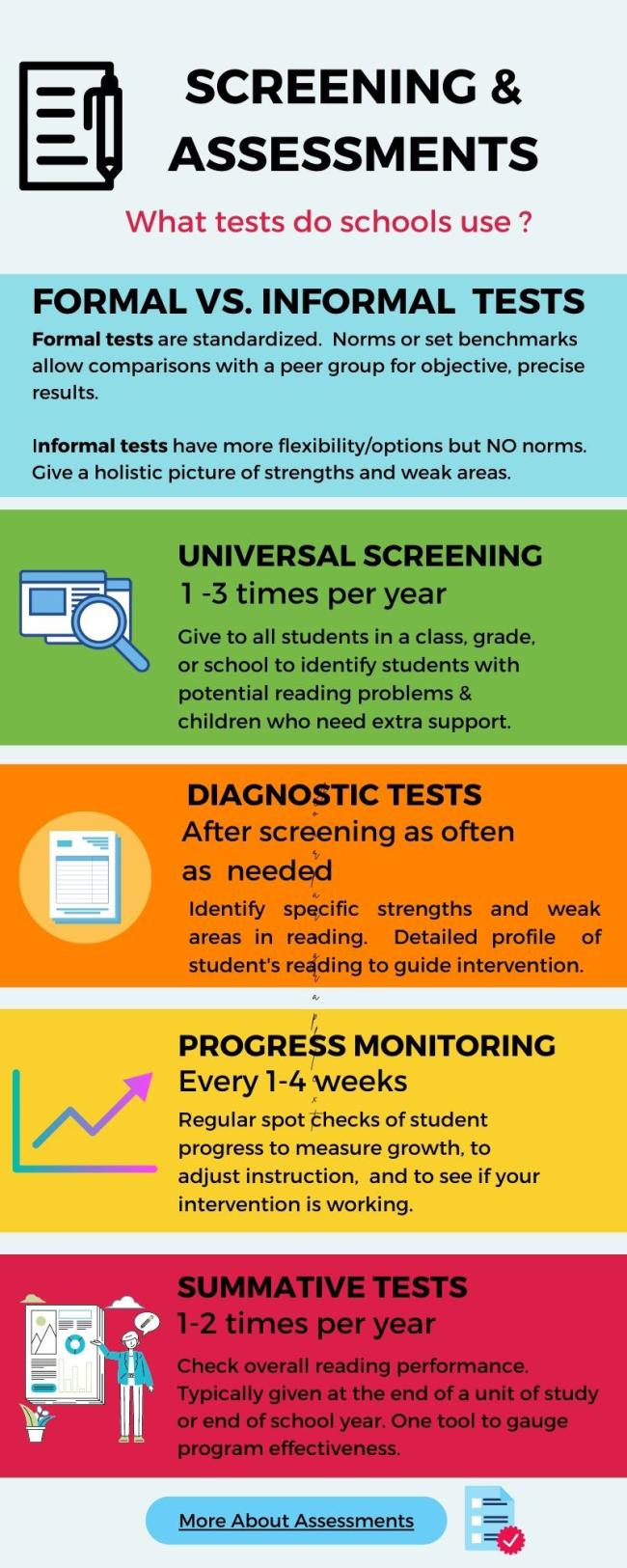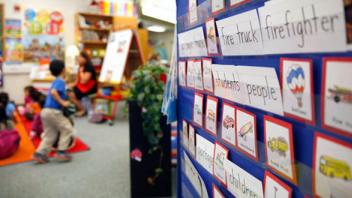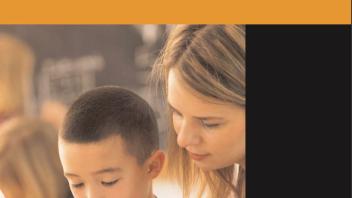Formal and informal assessments
How do teachers know what skills to target for classroom reading instruction? Schools use a range of formal and informal tests to measure progress and plan instruction and intervention.
Formal tests are standardized with a norm group or established benchmarks so you can compare a student’s results to peers. Formal tests require following specific directions and steps. They give an objective, precise view of reading performance. The Iowa Test of Basic Skills and the Test of Word Reading Efficiency (TOWRE) are two examples of formal tests used by some schools.
Informal tests are more flexible and provide a holistic view of a student’s reading. They do not have a norm group, so you can’t compare one student’s score to another. Informal tests can be observation checklists, informal reading inventories, teacher-made tests to name a few. One example of an informal reading test is the Qualitative Reading Inventory 7 (Leslie & Caldwell, 2021).
What do I want to know about my students?
There are different informal assessment tools for assessing various components of reading. It’s important to ask yourself: “What do I want to know about my students? What do I want to assess?” Reading Basics: Assessment
4 types of MTSS assessments
Within a MTSS framework, there are four types of reading assessments: universal screeners, diagnostic tests, progress monitoring tools, and summative assessments. Using formal and informal tools help schools determine who needs extra help, plan instruction, monitor growth, and evaluate program success.
Universal screeners
Universal screeners are tests that are given 1-3 times a year to a class, grade, or even an entire school to check for potential reading difficulties. Students who fail to meet a school’s established criteria may be at risk for reading problems or eligible for additional reading support.
Diagnostic assessments
Diagnostic assessments identify a student’s specific strengths and weaknesses in reading, for example, phonics or vocabulary skills. Diagnostic tests provide a detailed profile of the student’s needs to guide intervention. Diagnostic tests are given after a student fails a screener and may be repeated as often as needed by the teacher to find out more about the student’s reading skills.
Progress monitoring tools
Progress monitoring tools measure a student’s progress throughout instruction and intervention. They may be given weekly, bi-weekly, or monthly depending on the intensity of intervention and needs of the student. Progress monitoring tools report the student’s growth in reading and help the teacher to adjust instruction.
Summative assessments
Summative assessments are used to evaluate student performance at the end of an instructional period or school year. Two examples of summative assessments could be an end of unit test for a grade’s reading program or taking a state’s required reading test. Summative tests measure a student’s overall reading performance and effectiveness of the school’s reading program.

Research-based screeners and assessment tools
Most schools have a plethora of assessments they are using to check oral language, alphabet knowledge, phonological awareness, phonics, fluency, vocabulary, reading comprehension, and writing. Here are some common tools used to assess student performance.
Universal screening tools
Here are a few widely used universal screening tools for reading instruction:
- DIBELS (Dynamic Indicators of Basic Early Literacy Skills)
- Virginia Literacy Partnership — PALS (Phonological Awareness Literacy Screening)
- TPRI (Texas Primary Reading Inventory)
- AIMSweb (Assessments and Curriculum-Based Measurement)
- STAR Reading (Standardized Test for the Assessment of Reading)
- MAP Reading (Measures of Academic Progress)
- i-Ready Reading
- DRA (Developmental Reading Assessment)
The effectiveness of any screening tool will depend on how it is used and the context in which it is applied. Most schools have a test and times for screening all students. Consult with a reading specialist or literacy coach before choosing and administering a screening tool.
Diagnostic and progress monitoring tools
Many of the universal screening tools have additional subtests to diagnose reading problems and monitor student progress. Here are a few common tools used to diagnose (D) and/or monitor (PM) student reading. Note that some formal normed diagnostic tests can also be used for summative assessment (Sum)
- DIBELS (Dynamic Indicators of Basic Early Literacy Skills) — PM
- Virginia Literacy Partnership - PALS (Phonological Awareness Literacy Screening) — D, PM
- TPRI (Texas Primary Reading Inventory) — D, PM
- AIMSweb (Assessments and Curriculum-Based Measurement) — PM
- EasyCBM (Curriculum-Based Measurement) — PM
- Woodcock-Johnson Test of Achievement — D, Sum
- Gray Oral Reading Test (GORT) — D
- Test of Reading Comprehension (TORC) — D, Sum
- Kaufman Assessment Battery for Children (KABC) — D, Sum
- Comprehensive Test of Phonological Processing (CTOPP) — D
- Test of Word Reading Efficiency (TOWRE) — D
- Stanford Diagnostic Reading Test (SDRT) — D
- Qualitative Reading Inventory (QRI) — D
- Scholastic Reading Inventory (SRI) — D
- Gates-MacGinitie Reading Tests — D, Sum
Choosing a diagnostic or progress monitoring test depends on the age, grade, and the specific needs of the student to determine which reading skills to assess. Work with your school’s reading specialist or a literacy coach to select the most appropriate diagnostic and progress monitoring tests for your students.
Descriptions and reviews of popular reading assessments
The National Center on Intensive Intervention offers a comprehensive review of screening and progress monitoring tools:
Learn more
Try our free, self-paced learning module! Reading 101: Assessment
Learn more about screening and assessment
Right to Read
Data: The Closest Thing We Have to a Crystal Ball
Assessment and Evaluation
Early Reading Assessment: A Guiding Tool for Instruction
Shanahan on Literacy
How to Monitor Vocabulary Learning
Shanahan on Literacy
Are Oral Reading Norms Accurate with Complex Text?
Shanahan on Literacy
How to Analyze or Assess Reading Comprehension
Shanahan on Literacy
Should We Test Reading or DIBELS?
Assessment and Evaluation
Determining Adequate Yearly Progress From Kindergarten through Grade 6 with Curriculum-Based Measurement
Assessment and Evaluation
Common Types of Reading Problems and How to Help Children Who Have Them
Assessment and Evaluation
Student Progress Monitoring: What This Means for Your Child
Guides and Toolkits








